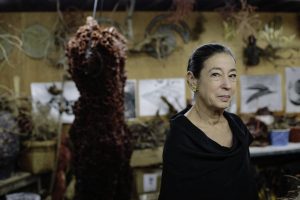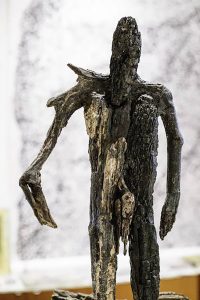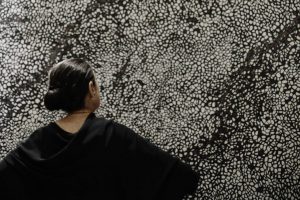An Artist Finds a Simple Way to Stay Young
Artist Michele Oka Doner considers age 70 celebratory and finds inspiration in shells and sea creatures
Sculptor Michele Oka Doner at her studio in Manhattan. PHOTO: ADRIENNE GRUNWALD FOR THE WALL STREET JOURNAL

For the 70-year-old artist Michele Oka Doner, your 60s are a singular, spectacular time of life. Complications such as high cholesterol and high blood pressure, notwithstanding, of course.
“In your 60s, you begin to reach the low-hanging fruit,” she explained as she sat in her SoHo studio last week. “Everything is ripening. This country doesn’t have a culture of ripening. It’s arrested adolescence.”
OK. So how about your 70s? I expected Ms. Oka Doner, to concede that the 70s is no gift basket. She declined to do so.
“It’s very celebratory,” she explained. “I’m motivated to finish the job. The job now—I didn’t know what it was when I started—has real shape.”
On the day of my visit, Ms. Oka Doner was preparing for a show of her work at the Pérez Art Museum Miami; she grew up in Miami Beach and her father served as the city’s mayor. Her public art commissions in the area have included “A Walk on the Beach,” a half-mile-long walkway at Miami International Airport inspired by the shells, saltwater plants and sea creatures of South Florida.
She may be best known in New York for “Radiant Site,” an installation of 11,000 bronze-colored, floor-to-ceiling tiles at the 34th Street-Herald Square subway station.
But I’d like to propose another possible explanation for the artist’s discovery of the fountain of youth: nature. And not just painting or sculpting it.
‘Hominin Relic VI,’ a wooden sculpture on display in Ms. Oka Doner’s studio. PHOTO: ADRIENNE GRUNWALD FOR THE WALL STREET JOURNAL
But also collecting nature. Her loft, where she both lives and works, is filled with shells and coral that date to her childhood. And her passion for the beach and its shimmering debris remains unabated.
“As an adult, I find things in the Hamptons,” she said as she showed me a case filled only with fish eye sockets.
There is another case containing bird skulls, including the polished cranium of an owl. “When I lived in Michigan, we lived on a hill, a geological moraine,” said Ms. Oka Doner, who attended the University of Michigan. She and her husband, Fred Doner, raised their two sons in Detroit and then in New York, where they moved in 1981.
For some reason, the topography of their neighborhood in Michigan spelled doom for lots of birds. “I would take them back to the garage and let nature do its course. If I was in a hurry, I’d speed up the cleaning with a little Clorox.”
I could appreciate the impulse. We have a “wunderkammer” at our home, a table filled with natural curiosities such as bird nests, colorful feathers, small animal skulls and insects that perished in excellent condition.
There are few ways more effective to reconnect with your inner 5-year-old than collecting artifacts in the woods or seashells and other treasures along an ocean shore.
Ms. Oka Doner’s studio is essentially one giant, fantastical and tastefully decorated wunderkammer.
Her bedroom, which overlooks her studio, consists of a queen-sized bed, twin 1740 Venetian palace chairs, and part of an aquatic-themed stage set for Wagner’s Das Rheingold by the early 20th-century Italian decorator Galileo Chini. The sensation is that of floating in an elegant aquarium. You almost expect a yellow submarine to come puttering by.
‘This country doesn’t have a culture of ripening. It’s arrested adolescence,’ said Ms. Oka Doner. PHOTO: ADRIENNE GRUNWALD FOR THE WALL STREET JOURNAL
I was curious to get the artist’s feelings about sea glass. Since I hadn’t spotted it in any of her collections. Too clichéd, perhaps?
“I like sea glass,” she said, as if she’d given the subject much thought. “You don’t see it anymore. Everything comes in aluminum cans. I have two necklaces of sea glass. I decided they were my emeralds.”
She has been deacquisitioning lately. “I gave my son his fossils,” she explained. “I had so many cigar boxes filled with fossils. I see my son already teaching the language” of feathers and sea fans “to his children.”
But all her collections are much more than elegant clutter. They serve as the spark for her work.
I think of my eye as somewhat educated when it comes to flotsam and jetsam. But it was hard to distinguish the real stuff from what Ms. Oka Doner and her assistants had manufactured in her studio and were on their way to the show in Miami; or for a commission for the Miami Ballet, where she’s providing the costumes and sets for Balanchine’s “A Midsummer Night’s Dream.”
Except that the scale of hers—geodes that looked forged by violent forces in the bowels of the Earth eons ago or conch shells that glistened as beautifully as any in nature—was noticeably larger and more heroic.
“You can’t collect them,” the artist joked. “They don’t exist.”




